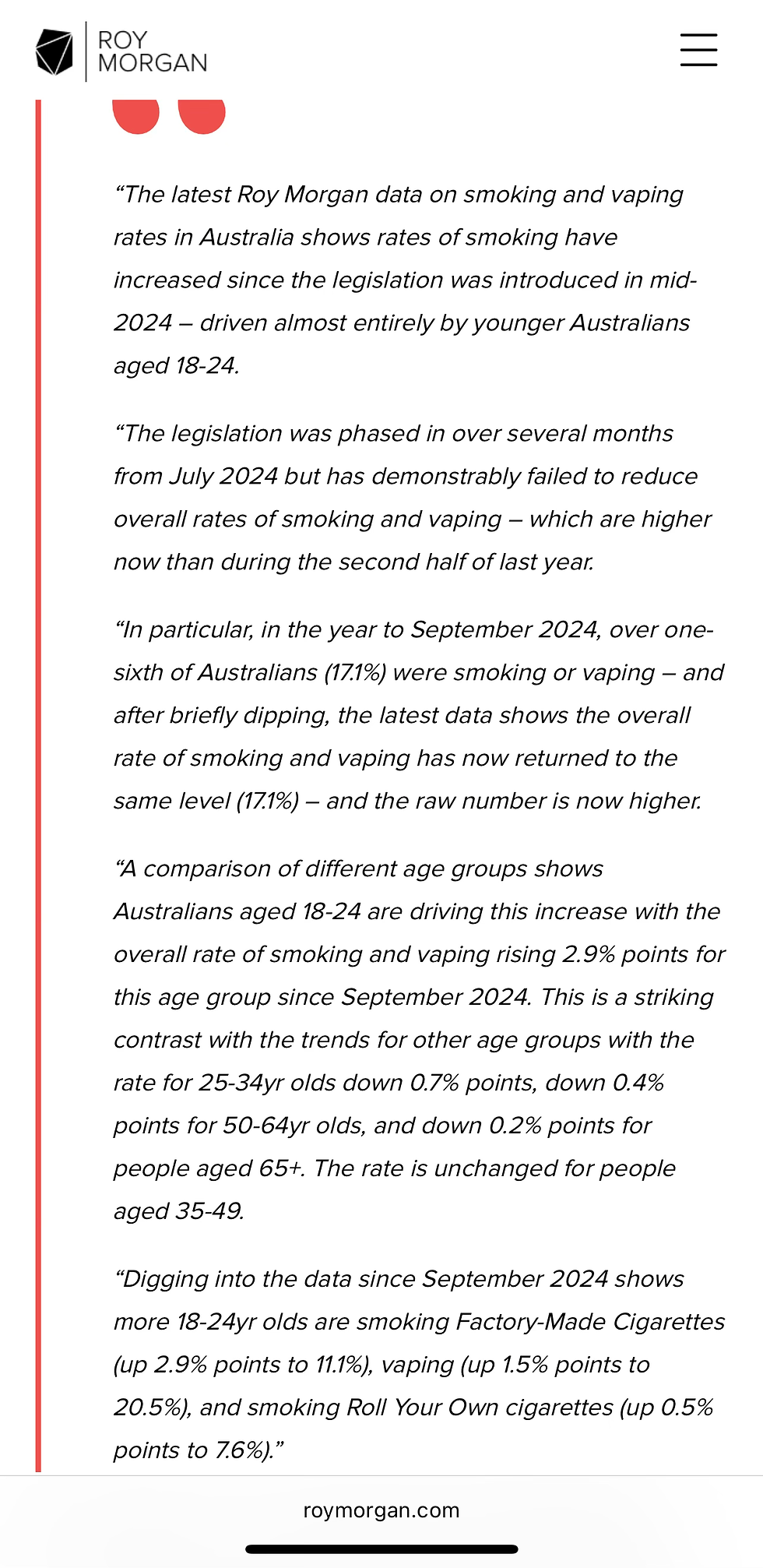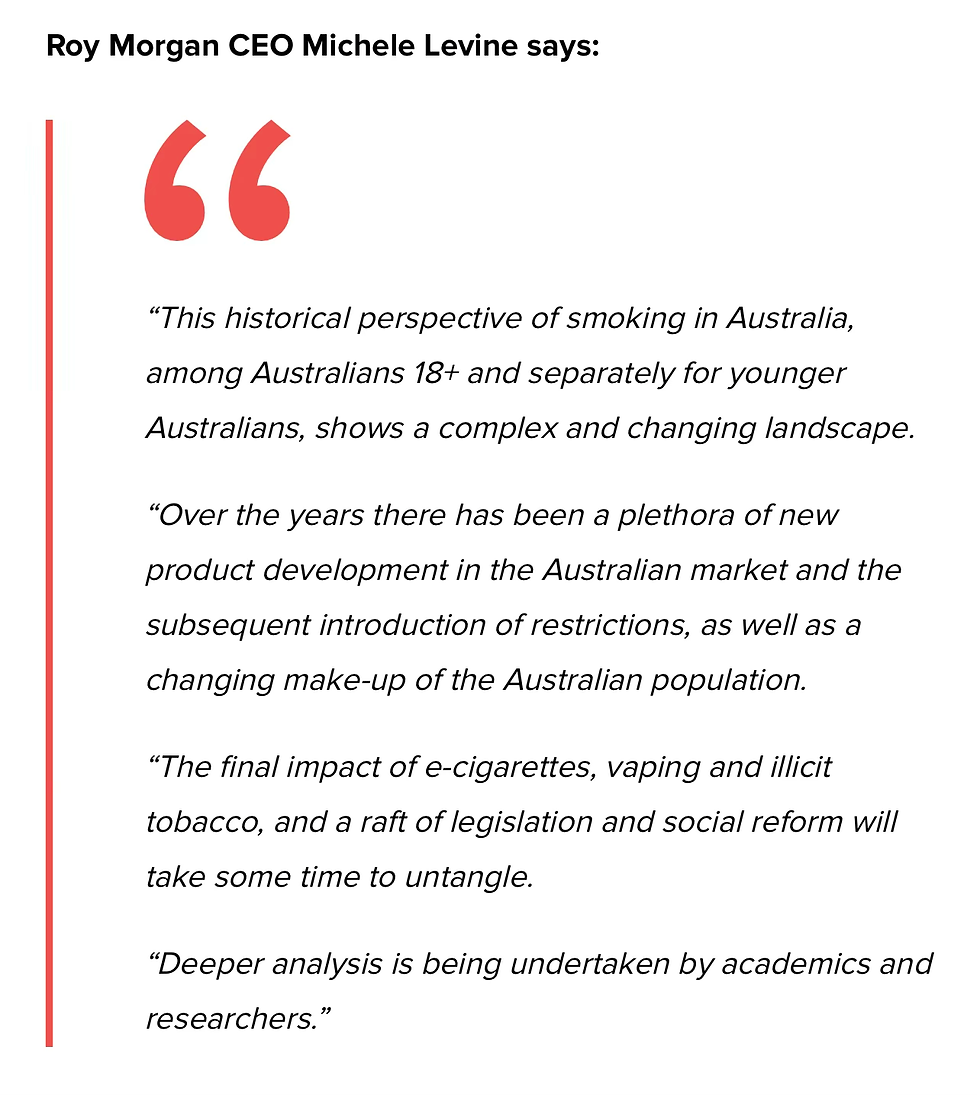What Will It Take for the Government to Face the Consequences of Its Tobacco Policies?
- Alan Gor

- Jul 26
- 4 min read

Alan Gor 27/07/2025
Australia has long held itself up as a world leader in tobacco control, and for a time, that reputation was deserved. However, in 2024–25, the country made a drastic mistake: rather than regulating vaping, it attempted to eliminate it through a sweeping ban on pharmacy/prescription-only sales.
The result? A perfect storm of black markets, misinformation, and now, according to national survey data, a worrying rise in youth smoking.
It’s a public health disaster in slow motion. But unless you’re paying close attention, you wouldn’t know it. The government won’t acknowledge it. The media won’t report it, and the public health establishment appears more concerned with defending its narrative than with facing the consequences of its own policies.
When the Data Contradicts the Narrative
According to Roy Morgan’s national tracking survey, smoking among 18–24-year-olds rose sharply in the aftermath of the vape crackdown from 11.9% in 2023 to 14.3% in 2025. Meanwhile, daily vaping rates among young people declined slightly.
A rational policy response would treat this as a wake-up call. Instead, the story was buried. Suppressed. Reframed and discredited not because the data was invalid, but because it was inconvenient.
And in July 2025, the full machinery of narrative control was put on display. Here’s how it played out.
The Roy Morgan Incident: Timeline of a Suppressed Story
July 1, 2025: Roy Morgan Releases the Bombshell Report
Roy Morgan publishes its 2025 update on smoking and vaping. Key findings:
Smoking among 18–24-year-olds jumps to 14.3% reversing a long-term decline.
Vaping rates among youth fall modestly.
The report flags a “concerning turnaround” in youth smoking, and suggests the vaping ban may have played a role.
The implications are huge. But the mainstream media? Dead silent.




July 4, 2025: Generation Vape Floods the Airwaves
Just three days later, a rival study is released: Generation Vape, led by Cancer Council NSW and the University of Sydney, and funded by the Department of Health.
The report relies on older data from 2023, focuses solely on vaping, and makes no mention of smoking. Nonetheless, it dominates media coverage, pushing the message that youth vaping is the real threat.
Lead researcher Becky Freeman becomes the public face of the story. She is a long-time proponent of Australia’s vape ban and has advised the government on its implementation.
July 5–7, 2025: Behind Closed Doors
Cancer Council Victoria, which receives federal funding to monitor Roy Morgan data, contacts the Department of Health five times in three days.
Health Minister Mark Butler is briefed on the situation.
Meanwhile, tobacco control researchers, including Freeman, began circulating internal critiques of the Roy Morgan report. A pressure campaign is clearly underway.
July 8, 2025: Roy Morgan Alters Its Report
Roy Morgan removes the original July 1 report from its website and replaces it with a revised version.
Key changes:
“Concerning turnaround” in youth smoking softened.
Smoking-focused graphs and language revised.
A new chart on vaping has been inserted.
Smoking-related insights are buried deeper in the report.
No explanation is given. The original version disappears without a trace. Altered Report here!

July 20, 2025: Freeman Confirms Pressure Was Applied
In an interview with The Saturday Paper, Becky Freeman confirms that a fellow researcher contacted Roy Morgan directly to complain.
“It was a very poorly done analysis and presentation… Roy Morgan was very responsive and helpful.”
She insists the data itself was sound, but that the “interpretation” was the problem, particularly the suggestion that the vaping crackdown might be linked to the smoking rise.

July 22, 2025: Roy Morgan Quietly Reinstates the Original

Mixed Messages: Roy Morgan’s Changing Tone
It’s not just the suppression of the data that’s alarming; it’s also the contrast in how it’s communicated.
Figure 1: The Data That Tells the Truth
Smoking is up 2.4 percentage points among young adults.
Factory-made cigarettes up 2.9 percentage points.
Vaping is still increasing.
Combined smoking/vaping rate is now 17.1%, higher than before the ban.
The implication is clear: Australia’s crackdown has failed. And young adults are paying the price.
Figure 2: The Softened Summary
Yet the other version, the actual report language, is far more blunt:
Roy Morgan CEO Michele Levine publicly described the situation as:
“A complex and changing landscape… The final impact of e-cigarettes, vaping and illicit tobacco will take some time to untangle.”
It’s cautious. It defers to “future analysis.” It avoids naming the ban directly. It’s the kind of phrasing you use when you want to avoid upsetting powerful stakeholders. This discrepancy between the corporate statement and the raw report raises serious concerns about how data is massaged to preserve reputations or protect political interests.
When public health data is this stark, soft-pedalling the message serves no one.
Final Reflection: What Will It Take?
We are now watching the real-world consequences of ideology-driven public health policy unfold:
Smoking is rising among young adults.
Vapers are pushed into black markets or back to cigarettes.
The media refuses to report it.
Researchers with conflicts of interest steer the narrative.
So again: What will it take for the government to acknowledge the mess it’s created? The Roy Morgan incident reveals the extent of the deception. If more internal documents, FOI requests, or whistleblowers come forward, the credibility of the vaping crackdown would collapse.
Public Pressure
When people realise their kids are smoking again, change may follow, but only if they’re told the truth.
Media Courage
Just one outlet breaking ranks could expose this. Until then, silence rules.
Political Consequences
No reform happens unless it costs votes. That pressure must be applied.
Transparency
This moment demands honest science, not selectively sanitised messaging.
Final Thoughts
This isn’t just a policy failure. It’s a case study in what happens when evidence-based public health is replaced with narrative-first activism, propped up by compliant media and politically connected academics desperate for more funding.
Suppose Australia wants to regain credibility in tobacco control and protect young people from the very thing we claimed to be fighting. In that case, we must demand accountability, transparency, and above all: respect for data, not dogma.
Australia’s tobacco policy isn’t failing because of a lack of data. It’s failing because those in power are unwilling to face it.


